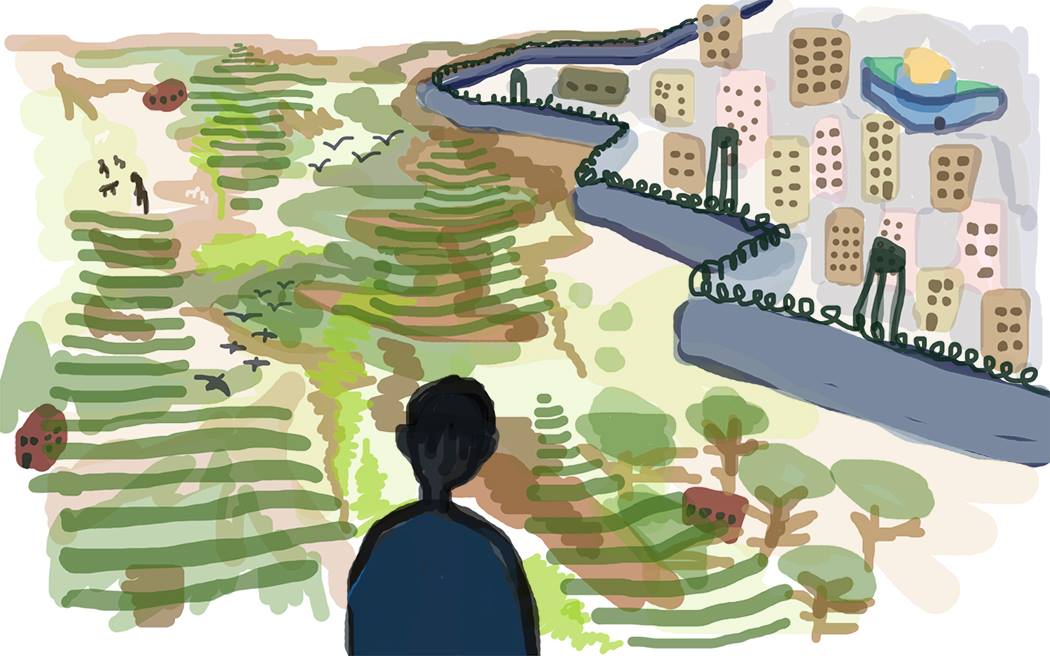I look out at the hills surrounding Awarta, a rural Palestinian village in the north of the occupied West Bank.
I squint at the sun slowly descending into distant valleys and listen to the whisper of the wings of birds flapping in the trees.
The view in front of me tells the brave story of modern-day Palestine. To the naked, uninformed eye, one could say it was simply beautiful.
To the southeast, my friend points to the fields of the Palestinian village of Aqraba.
Luscious green pastures slowly succumb to the impending shadows of sunset, and meadows of olive trees line the horizon.
Block-shaped houses are scattered around the base of the surrounding hills, clumped together in a surviving pocket of Palestinian life.
Just beyond the concrete buildings, I can make out the fields of illegal settlements lying further to the south, land confiscated from Palestinians and cultivated by Israeli settlers.
All previous attempts to work their land by Palestinian farmers were met with physical attacks to their person and property by Israeli settlers, and Israeli army intervention to “protect” them.
Facing the northeast, the illegal Israeli settlements of Itamar and Hanekuda perch atop the hills.
The red roofs form a polka-dotted pattern across the green background, spilling down the incline, seeping towards the fields below.
New housing units are built almost annually, as Israeli settlements spread like water spilling out of an overturned glass.
Below our lookout point to the northwest, an electric fence borders the large square of an Israeli military base.
Ragged, faded green cloth hangs from the fence, loose scraps flapping in the wind. The grey patch of land it is built around stands out from its green surroundings, forcing me to look at the multiple military observation towers outlining the base.
The dull grey cylindrical towers interrupt the otherwise crisp blue sky, intimidating windows glaring back at the setting sun.
From my high point of observation, I watch cars stream around the roundabout near the Huwara checkpoint, separating the Israeli-only roads leading to the nearby settlements from the ones going towards Nablus.
One lane for Israel license plates, another for Palestinian ones. I see a car pull over, and the driver is approached by a soldier for whatever reason the soldier has decided.
To the west, the sun has reached the horizon, glowing across the sky. Yellow and purple light reflects on the gravestones of the Awarta cemetery we are standing in, illuminating the dark black Arabic writing etched into the stones.
My friend points to a house just beyond the illegal settlement of Itamar.
“This house is owned by my family,” Aiman says. “When I was a kid, we used to go. But now, since I got out of jail, things have changed, and we don’t go. We are scared. Settlers will attack us. They attack anyone who comes near them.”
Aiman was imprisoned for ten-and-a-half years in Israeli military prisons, jailed for being involved in small-scale resistance to army invasions and raids of Awarta during the Second Intifada at the age of 20.
Before he was arrested, there were no settlements surrounding his village. When he was released, he came home to stories such as those of two young boys shot while playing in the fields to the northeast, dangerously close to Itamar.
The boys were killed by Israeli settlers. The settlers were not arrested or ever charged. In retaliation, some youth from Awarta attacked the settlement, injuring Israelis. These youth were immediately arrested, and the homes of their families raided.
“This is my country. Why are [Israelis] building in my country? Israel stole everything—trees, land, lives. Why here we cannot breathe? The hands of Israel wring around our necks,” Aiman lamented.
We walk through the graves of the cemetery, approaching a small building. Crouching, we enter its low door, our voices echoing under the domed roof. Aiman explains that this is an old Jewish house of prayer.
He knows this because every two weeks or so, Jewish settlers are escorted into the city by a military convoy around midnight.
The soldiers arrive in advance and stake out their surveillance spots atop Palestinian villagers’ roofs, invading their homes without warning or consent.
The Israeli army lines the narrow village streets, and the settlers march towards the ancient building, protected by their military in a land which is not theirs.
“We have no problems with the Jews,” Aiman offers. “We just have a problem with the occupation. I respect them, the Jews, but I cannot respect or accept life like this.”
Located in Area C, under full Israeli military control, the rural Palestinian hills surrounding Awarta are not unique; the diverse landscapes and the stories they tell are mirrored across Palestine.
Extending over 60 per cent of the West Bank, governance of Area C is racially segregated; Jewish Israeli citizens living in illegal settlements are subject to Israeli law and protected by the Israeli army, while Palestinians are subject to a system of military law determined by the decisions of Israeli military courts rather than a developed legal structure accountable to democratic governance.
“I just want to be free,” my friend Samer tells me. “I want to get as far away from the occupation as possible. I don’t want to see checkpoints, soldiers, settlers. I want to sleep at night and not worry about my family. I don’t want jail again.”
In the fields and valleys of Palestine, it is sometimes too easy to believe that one can breathe freely, that the warmth of the peaceful sky radiates beyond temperature.
Unfortunately, the images of untouched hills, full of history and life, are slowly being eradicated by Israeli expansion and violence.
In the moments of silence, however, the air of Palestine blows through the leaves of olive trees, and reminds me not to forget the beauty and calm that the occupation is trying so desperately to erase.
